Physiological and Biochemical Responses and Transcriptome Analysis of Bangia fuscopurpurea (Rhodophyta) Under High-Temperature Stress
Abstract
1. Introduction
2. Materials and Methods
2.1. Seaweed Samples and Temperature Treatment
2.2. Determination of Relative Growth Rate and Fluorescence Parameters
2.3. Measurement of Chlorophyll a and Carotenoids
2.4. Algal Phycobiliprotein Determination
2.5. Library Preparation for Transcriptome Sequencing
2.6. Quality Control, Transcriptome Assembly, and Gene Function Annotation
2.7. Analysis of Differentially Expressed Genes
2.8. Statistical Analysis
3. Results
3.1. Changes in Photosynthetic Pigments and Fluorescence Parameters Under Different Temperatures
3.2. Data Quality
3.3. Gene Function Annotation
3.4. Differential Gene Analysis
3.4.1. Overview of Differentially Expressed Genes
3.4.2. Analysis of Differentially Expressed Genes Using GO and KEGG Databases
3.4.3. KEGG Differential Expression Pathway Analysis
Photosynthesis Pathway
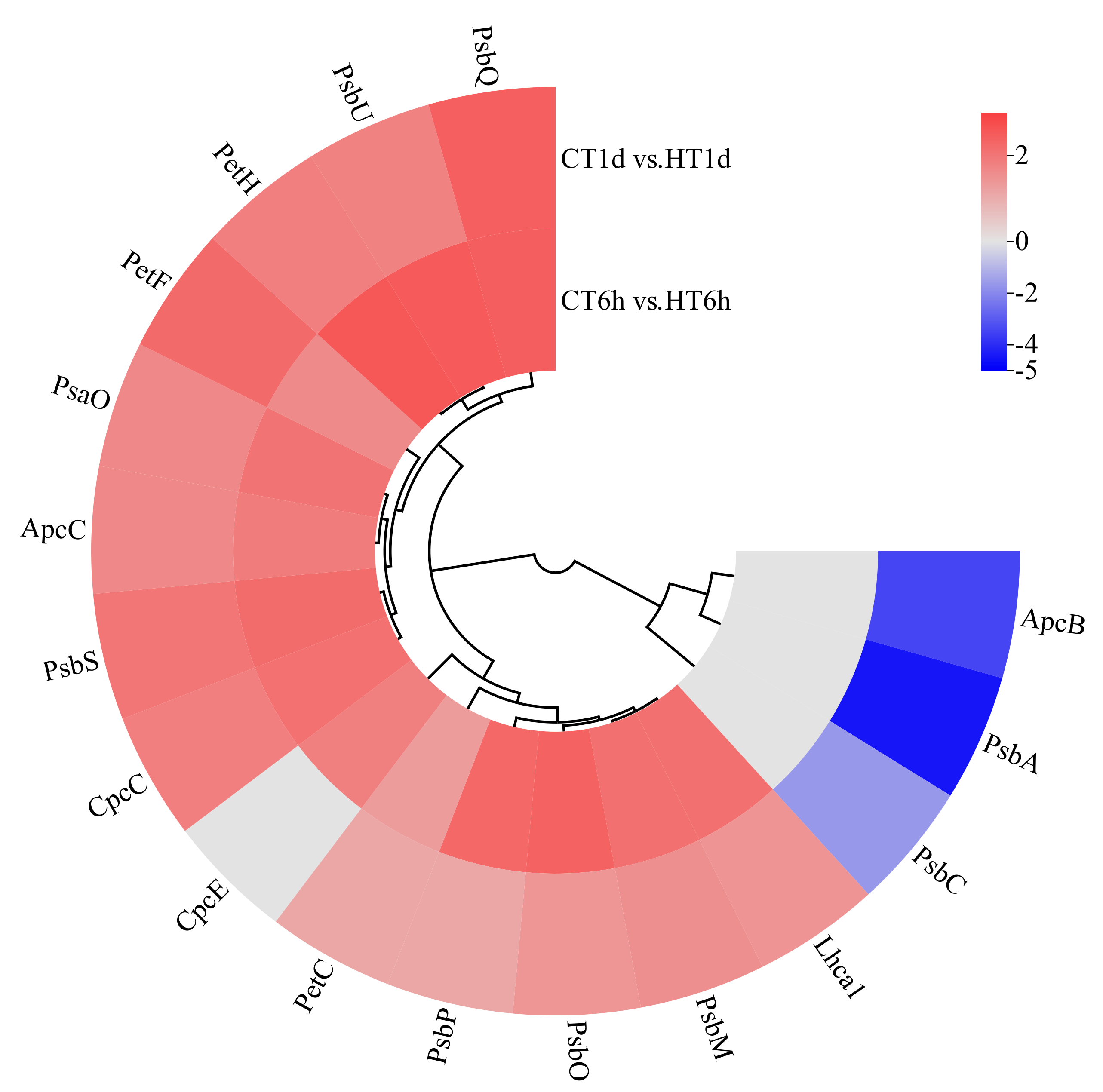
Carbohydrate Synthesis and Energy Metabolism Pathways
Glycerophospholipid Metabolism Pathway
Glutathione Metabolism Pathway
4. Discussion
4.1. The Influence of Temperature on Photosynthetic Pigments and Fluorescence Parameters
4.2. The Influence of Temperature on the Photosynthetic Pathway
4.3. The Influence of Temperature on Carbohydrate Synthesis and Energy Metabolism Pathways
4.4. The Influence of Temperature on Glycerophospholipid Metabolism
4.5. The Influence of Temperature on Glutathione Metabolism
4.6. The Gene Regulatory Mechanism Under High-Temperature Stress
5. Conclusions
Supplementary Materials
Author Contributions
Funding
Institutional Review Board Statement
Informed Consent Statement
Data Availability Statement
Acknowledgments
Conflicts of Interest
References
- Ji, Y.; Gao, K. Effects of climate change factors on marine macroalgae: A review. Adv. Mar. Biol. 2021, 88, 91–136. [Google Scholar] [PubMed]
- Masson-Delmotte, V.; Zhai, P.; Pirani, A.; Connors, S.L.; Péan, C.; Berger, S.; Caud, N.; Chen, Y.; Goldfarb, L.; Gomis, M. Climate change 2021: The physical science basis. In Contribution of Working Group I to the Sixth Assessment Report of the Intergovernmental Panel on Climate Change; Intergovernmental Panel on Climate Change: Geneva, Switzerland, 2021; Volume 2, p. 2391. [Google Scholar]
- Shuang, Y.; Kosuke, H.; Qian, A. Acceleration in the Global Mean Sea Level Rise: 2005–2015. Geophys. Res. Lett. 2017, 44, 11905–11913. [Google Scholar] [CrossRef]
- Arno von, K.; Andrew, S.; Gabriele, C.H. Marine heatwaves in global sea surface temperature records since 1850. Environ. Res. Lett. 2022, 17, 084027. [Google Scholar] [CrossRef]
- Polyakov, I.V.; Pnyushkov, A.V.; Alkire, M.B.; Ashik, I.M.; Baumann, T.M.; Carmack, E.C.; Goszczko, I.; Guthrie, J.; Ivanov, V.V.; Kanzow, T.; et al. Greater role for Atlantic inflows on sea-ice loss in the Eurasian Basin of the Arctic Ocean. Science 2017, 356, 285–291. [Google Scholar] [CrossRef]
- Gao, G.; Beardall, J.; Jin, P.; Gao, L.; Xie, S.; Gao, K. A review of existing and potential blue carbon contributions to climate change mitigation in the Anthropocene. J. Appl. Ecol. 2022, 59, 1686–1699. [Google Scholar] [CrossRef]
- Huang, Y.; Cui, J.; Wang, S.; Chen, X.; Liao, J.; Guo, Y.; Xin, R.; Huang, B.; Xie, E. Transcriptome analysis reveals the molecular mechanisms of adaptation to high temperatures in Gracilaria bailinae. Front. Plant Sci. 2023, 14, 1125324. [Google Scholar] [CrossRef]
- Kaori, M.; Yoko, Y.; Kanji, N.; Takato, F.; Naoya, S.; Tatsuo, U.; Yohko, S.-K.; Masayuki, K. Seasonal variation in the chemical composition of a marine brown alga, Sargassum horneri (Turner) C. Agardh. J. Food Compos. Anal. 2011, 24, 231–236. [Google Scholar] [CrossRef]
- Pang, S.J.; Jin, Z.H.; Sun, J.Z.; Gao, S.Q. Temperature tolerance of young sporophytes from two populations of Laminaria japonica revealed by chlorophyll fluorescence measurements and short-term growth and survival performances in tank culture. Aquaculture 2007, 262, 493–503. [Google Scholar] [CrossRef]
- Kumar, Y.N.; Poong, S.-W.; Gachon, C.; Brodie, J.; Sade, A.; Lim, P.-E. Impact of elevated temperature on the physiological and biochemical responses of Kappaphycus alvarezii (Rhodophyta). PLoS ONE 2020, 15, e0239097. [Google Scholar] [CrossRef]
- Liu, L.; Zou, D.; Jiang, H.; Chen, B.; Zeng, X. Effects of increased CO2 and temperature on the growth and photosynthesis in the marine macroalga Gracilaria lemaneiformis from the coastal waters of South China. J. Appl. Phycol. 2018, 30, 1271–1280. [Google Scholar] [CrossRef]
- Zou, D.; Gao, K. Temperature response of photosynthetic light- and carbon-use characteristics in the red seaweed Gracilariopsis lemaneiformis (Gracilariales, Rhodophyta). J. Phycol. 2014, 50, 366–375. [Google Scholar] [CrossRef]
- Broom, J.; Farr, T.; Nelson, W. Phylogeny of the Bangia flora of New Zealand suggests a southern origin for Porphyra and Bangia (Bangiales, Rhodophyta). Mol. Phylogenetics Evol. 2004, 31, 1197–1207. [Google Scholar] [CrossRef] [PubMed]
- Ma, J.-H.; Li, S.-J.; Ji, H.-H. An analysis of amino acids and fatty acids in Bangia. Chin. J. Mar. Drugs 2002, 21, 40–42. [Google Scholar]
- Shuijun, L.; Jiahai, M.; Huanhong, J.; Enyi, X. Evaluation of nutrient components of Bangia sp. Acta Oceanol. Sin. 2003, 22, 89–95. [Google Scholar]
- Wenjun, W.; Jianyi, Z.; Pao, X.; Jianrong, X.; Xiang-zhi, L.; Chun-Kai, H.; Weibin, S.; Guang, P.; Guangce, W. Characterization of the life history of Bangia fuscopurpurea (Bangiaceae, Rhodophyta) in connection with its cultivation in China. Aquaculture 2008, 278, 101–109. [Google Scholar] [CrossRef]
- Yong, Y.S.; Yong, W.T.L.; Anton, A. Analysis of formulae for determination of seaweed growth rate. J. Appl. Phycol. 2013, 25, 1831–1834. [Google Scholar] [CrossRef]
- Li, C.; Nong, Q.; Solanki, M.K.; Liang, Q.; Xie, J.; Liu, X.; Li, Y.; Wang, W.; Yang, L.; Li, Y. Differential expression profiles and pathways of genes in sugarcane leaf at elongation stage in response to drought stress. Sci. Rep. 2016, 6, 25698. [Google Scholar] [CrossRef]
- Porra, R.J. The chequered history of the development and use of simultaneous equations for the accurate determination of chlorophylls a and b. Photosynth. Res. 2002, 73, 149–156. [Google Scholar] [CrossRef]
- Beer, S.; Eshel, A. Determining phycoerythrin and phycocyanin concentrations in aqueous crude extracts of red algae. Mar. Freshw. Res. 1985, 36, 785–792. [Google Scholar] [CrossRef]
- Piñeiro-Corbeira, C.; Barreiro, R.; Cremades, J.; Arenas, F. Seaweed assemblages under a climate change scenario: Functional responses to temperature of eight intertidal seaweeds match recent abundance shifts. Sci. Rep. 2018, 8, 12978. [Google Scholar] [CrossRef]
- Yang, F.; Wei, Z.; Long, L. Transcriptomic and Physiological Responses of the Tropical Reef Calcified Macroalga Amphiroa fragilissima to Elevated Temperature1. J. Phycol. 2021, 57, 1254–1265. [Google Scholar] [CrossRef] [PubMed]
- Wilson, K.L.; Kay, L.M.; Schmidt, A.L.; Lotze, H.K. Effects of increasing water temperatures on survival and growth of ecologically and economically important seaweeds in Atlantic Canada: Implications for climate change. Mar. Biol. 2015, 162, 2431–2444. [Google Scholar] [CrossRef]
- Zulfiqar, S.; Sharif, S.; Saeed, M.; Tahir, A. Role of carotenoids in photosynthesis. In Carotenoids: Structure and Function in the Human Body; Springer: Berlin/Heidelberg, Germany, 2021; pp. 147–187. [Google Scholar]
- Yang, J.J.; Yu, D.C.; Ma, Y.F.; Yin, Y.; Shen, S.D. Antioxidative defense response of Ulva prolifera under high or low-temperature stimulus. Algal Res. 2019, 44, 101703. [Google Scholar] [CrossRef]
- Ma, C.; Qin, S.; Cui, H.; Liu, Z.; Zhuang, L.; Wang, Y.; Zhong, Z. Nitrogen enrichment mediates the effects of high temperature on the growth, photosynthesis, and biochemical constituents of Gracilaria blodgettii and Gracilaria lemaneiformis. Environ. Sci. Pollut. Res. 2021, 28, 21256–21265. [Google Scholar] [CrossRef] [PubMed]
- Ma, J.; Jiangnan, H.; Xinmei, S.; Demei, M.; Yang, R. Phycobiliproteins, the pigment-protein complex form of natural food colorants and bioactive ingredients. Crit. Rev. Food Sci. Nutr. 2024, 64, 2999–3017. [Google Scholar] [CrossRef]
- Kim, E.Y.; Choi, Y.H.; Nam, T.J. Identification and antioxidant activity of synthetic peptides from phycobiliproteins of Pyropia yezoensis. Int. J. Mol. Med. 2018, 42, 789–798. [Google Scholar] [CrossRef]
- Gao, T.; Tang, X.; Wang, D.; Yu, Y.; Mao, Y. Morpho-physiological and transcriptomic analyses reveal adaptive responses of Neopyropia yezoensis to long-term high temperature. Plant Stress. 2025, 15, 100778. [Google Scholar] [CrossRef]
- Muhammad, I.; Shalmani, A.; Ali, M.; Yang, Q.-H.; Ahmad, H.; Li, F.B. Mechanisms regulating the dynamics of photosynthesis under abiotic stresses. Front. Plant Sci. 2021, 11, 615942. [Google Scholar] [CrossRef]
- Zhang, L.; Chang, Q.; Hou, X.; Wang, J.; Chen, S.; Zhang, Q.; Wang, Z.; Yin, Y.; Liu, J. The effect of high-temperature stress on the physiological indexes, chloroplast ultrastructure, and photosystems of two herbaceous peony cultivars. J. Plant Growth Regul. 2023, 42, 1631–1646. [Google Scholar] [CrossRef]
- Wu, J.; Lian, W.; Liu, Z.; Zeng, X.; Jiang, J.; Wei, Y. High temperature response of chlorophy II fluorescence parameters and heat tolerance evaluation of different grape cultivars. J. Northwest A F Univ. 2019, 47, 80–88. [Google Scholar]
- Borlongan, I.A.G.; Gerung, G.S.; Nishihara, G.N.; Terada, R. Light and temperature effects on photosynthetic activity of Eucheuma denticulatum and Kappaphycus alvarezii (brown and green color morphotypes) from Sulawesi Utara, Indonesia. Phycol. Res. 2017, 65, 69–79. [Google Scholar] [CrossRef]
- Li, Q.; Zhang, L.; Pang, T.; Liu, J. Comparative transcriptome profiling of Kappaphycus alvarezii (Rhodophyta, Gigartinales) in response to two extreme temperature treatments: An RNA-seq-based resource for photosynthesis research. Eur. J. Phycol. 2019, 54, 162–174. [Google Scholar] [CrossRef]
- Qin, F.; Zang, X.; Shui, G.; Wang, Z. Transcriptome analysis of Gracilariopsis lemaneiformis at low temperature. J. Appl. Phycol. 2021, 33, 4035–4050. [Google Scholar] [CrossRef]
- Saluri, M.; Kaldmäe, M.; Tuvikene, R. Extraction and quantification of phycobiliproteins from the red alga Furcellaria lumbricalis. Algal Res. 2019, 37, 115–123. [Google Scholar] [CrossRef]
- You, X.; Zhang, X.; Cheng, J.; Xiao, Y.; Ma, J.; Sun, S.; Zhang, X.; Wang, H.-W.; Sui, S.-F. In situ structure of the red algal phycobilisome–PSII–PSI–LHC megacomplex. Nature 2023, 616, 199–206. [Google Scholar] [CrossRef]
- Dai, W.; Wang, X.; Zhuang, M.; Sun, J.; Shen, Y.; Xia, Z.; Wu, T.; Jiang, R.; Li, A.; Bi, F.; et al. Responses of photosynthesis-related genes in Sargassum horneri to high temperature stress. Mar. Pollut. Bull. 2024, 199, 115944. [Google Scholar] [CrossRef] [PubMed]
- Wang, W.; Lin, Y.; Teng, F.; Ji, D.; Xu, Y.; Chen, C.; Xie, C. Comparative transcriptome analysis between heat-tolerant and sensitive Pyropia haitanensis strains in response to high temperature stress. Algal Res. 2018, 29, 104–112. [Google Scholar] [CrossRef]
- Wang, T.; Gao, M.; Song, H.; Wang, C.; He, M. Low temperature modulates the carbon allocation in different metabolic pathways to improve the tolerance of Arctic Chlorella to high light stress. Algal Res. 2024, 80, 103562. [Google Scholar] [CrossRef]
- Barati, B.; Gan, S.Y.; Lim, P.E.; Beardall, J.; Phang, S.M. Green algal molecular responses to temperature stress. Acta Physiol. Plant. 2019, 41, 26. [Google Scholar] [CrossRef]
- Li, X.; Manuel, J.; Slavens, S.; Crunkleton, D.W.; Johannes, T.W. Interactive effects of light quality and culturing temperature on algal cell size, biomass doubling time, protein content, and carbohydrate content. Appl. Microbiol. Biotechnol. 2021, 105, 587–597. [Google Scholar] [CrossRef]
- Lv, Y.; Sun, P.; Zhang, Y.; Xuan, W.; Xu, N.; Sun, X. Response of trehalose, its degrading enzyme, sucrose, and floridoside/isofloridoside under abiotic stresses in Gracilariopsis lemaneiformis (Rhodophyta). J. Appl. Phycol. 2019, 31, 3861–3869. [Google Scholar] [CrossRef]
- Li, H.; Monteiro, C.; Heinrich, S.; Bartsch, I.; Valentin, K.; Harms, L.; Glöckner, G.; Corre, E.; Bischof, K. Responses of the kelp Saccharina latissima (Phaeophyceae) to the warming Arctic: From physiology to transcriptomics. Physiol. Plant. 2020, 168, 5–26. [Google Scholar] [CrossRef] [PubMed]
- Iñiguez, C.; Galmés, J.; Gordillo, F.J.L. Rubisco carboxylation kinetics and inorganic carbon utilization in polar versus cold-temperate seaweeds. J. Exp. Bot. 2019, 70, 1283–1297. [Google Scholar] [CrossRef]
- Lemieux, H.; Blier, P.U. Exploring thermal sensitivities and adaptations of oxidative phosphorylation pathways. Metabolites 2022, 12, 360. [Google Scholar] [CrossRef] [PubMed]
- Zhang, X.; Hu, C.; Sun, X.; Zang, X.; Zhang, X.; Fang, T.; Xu, N. Comparative transcriptome analysis reveals chitooligosaccharides-induced stress tolerance of Gracilariopsis lemaneiformis under high temperature stress. Aquaculture 2020, 519, 734876. [Google Scholar] [CrossRef]
- Liu, L.; Lin, L. Effect of Heat Stress on Sargassum fusiforme Leaf Metabolome. J. Plant Biol. 2020, 63, 229–241. [Google Scholar] [CrossRef]
- Gonzalez-Baro, M.R.; Coleman, R.A. Mitochondrial acyltransferases and glycerophospholipid metabolism. Biochim. Et Biophys. Acta (BBA)-Mol. Cell Biol. Lipids 2017, 1862, 49–55. [Google Scholar] [CrossRef]
- Liang, Y.; Huang, Y.; Liu, C.; Chen, K.; Li, M. Functions and interaction of plant lipid signalling under abiotic stresses. Plant Biol. 2023, 25, 361–378. [Google Scholar] [CrossRef]
- Zhang, X.; Wu, C.; Hu, C.; Li, Y.; Sun, X.; Xu, N. Lipid remodeling associated with chitooligosaccharides-induced heat tolerance of marine macroalgae Gracilariopsis lemaneiformis. Algal Res. 2020, 52, 102113. [Google Scholar] [CrossRef]
- Zhang, J.; Liu, S.; Hu, C.; Chen, X.; Sun, X.; Xu, N. Physiological and Transcriptome Analysis of Exogenous L-Arginine in the Alleviation of High-Temperature Stress in Gracilariopsis lemaneiformis. Front. Mar. Sci. 2021, 8, 784586. [Google Scholar] [CrossRef]
- Pandey, A.K.; Gautam, A. Stress responsive gene regulation in relation to hydrogen sulfide in plants under abiotic stress. Physiol. Plant. 2020, 168, 511–525. [Google Scholar] [CrossRef] [PubMed]
- Suliman, M.S.E.; Elradi, S.B.M.; Zhou, G.; Meng, T.; Zhu, G.; Xu, Y.; Nimir, N.E.A.; Elsiddig, A.M.I.; Awdelseid, A.H.M.; Ali, A.Y.A. Exogenous glutathione protected wheat seedling from high temperature and water deficit damages. Sci. Rep. 2024, 14, 5304. [Google Scholar] [CrossRef] [PubMed]
- Moenne, A.; González, A.; Sáez, C.A. Mechanisms of metal tolerance in marine macroalgae, with emphasis on copper tolerance in Chlorophyta and Rhodophyta. Aquat. Toxicol. 2016, 176, 30–37. [Google Scholar] [CrossRef] [PubMed]
- Celis-Plá, P.S.M.; Moenne, F.; Rodríguez-Rojas, F.; Pardo, D.; Lavergne, C.; Moenne, A.; Brown, M.T.; Huovinen, P.; Gómez, I.; Navarro, N.; et al. Antarctic intertidal macroalgae under predicted increased temperatures mediated by global climate change: Would they cope? Sci. Total Environ. 2020, 740, 140379. [Google Scholar] [CrossRef]
- Niu, C.; Wang, W.; Yao, H.; Liang, Z.; Zhang, P.; Lu, X. Ascorbate−glutathione cycle involving in response of Bangia fuscopurpurea (Bangiales, Rhodophyta) to hyposalinity. Front. Mar. Sci. 2023, 10, 1174472. [Google Scholar] [CrossRef]
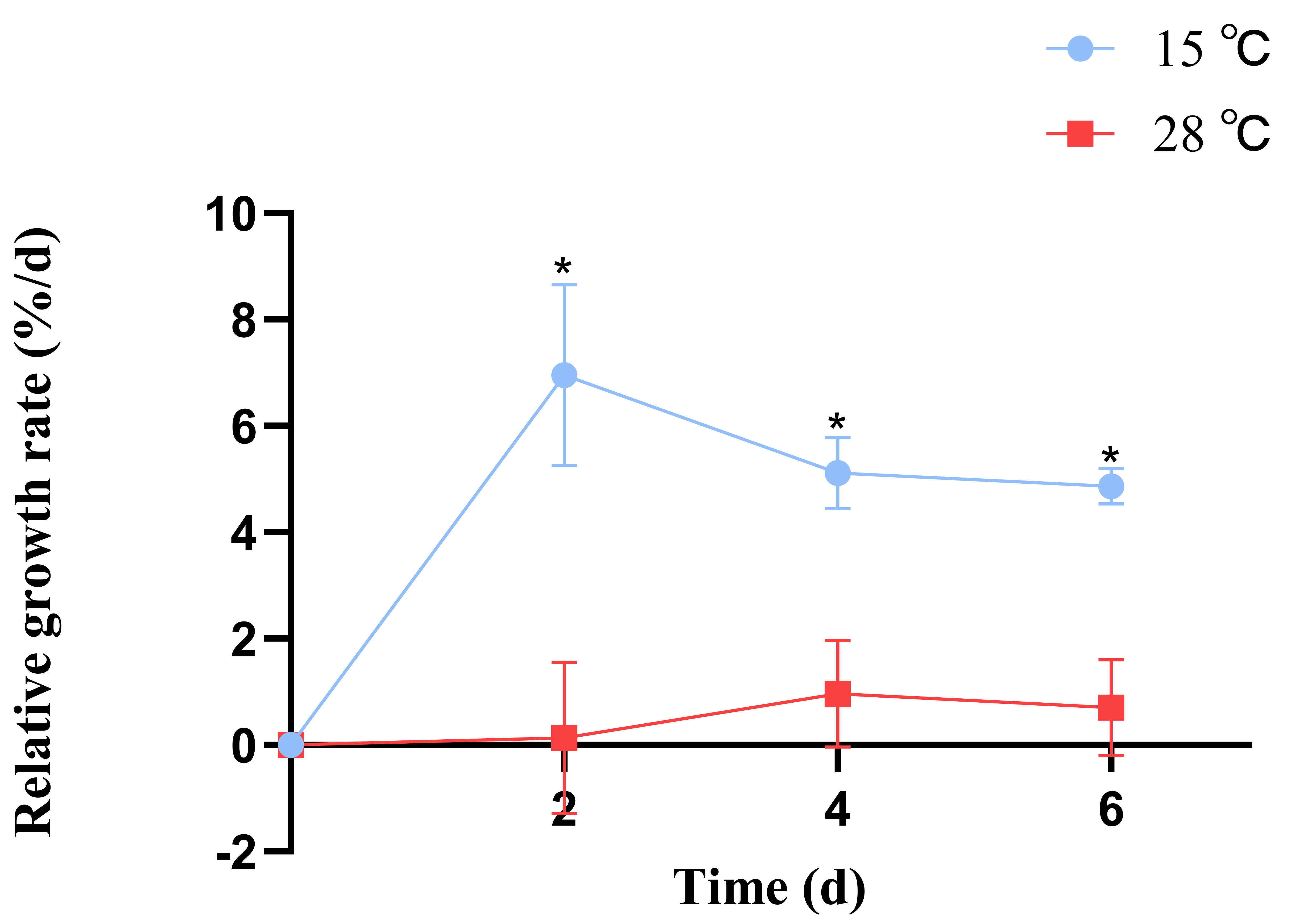
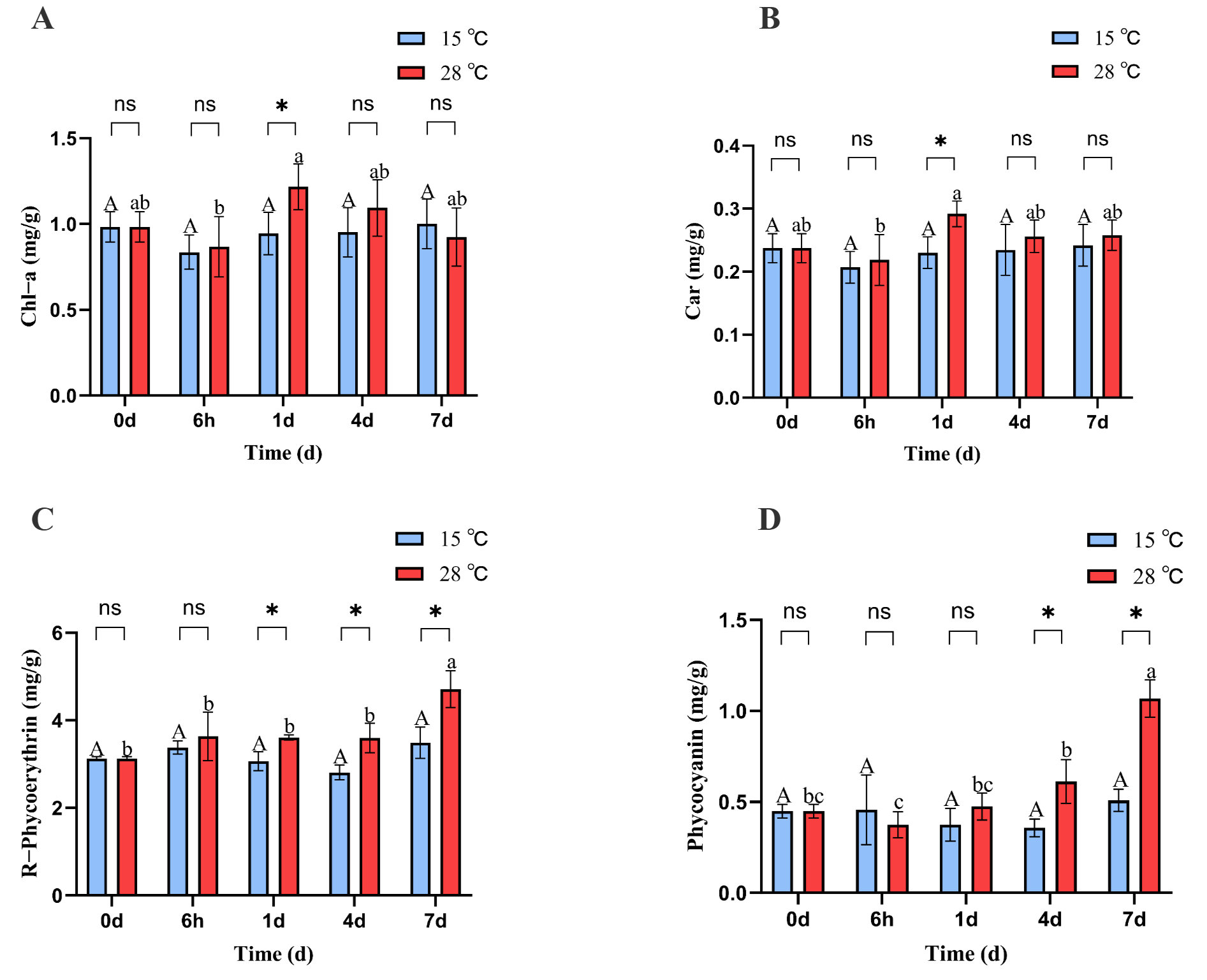
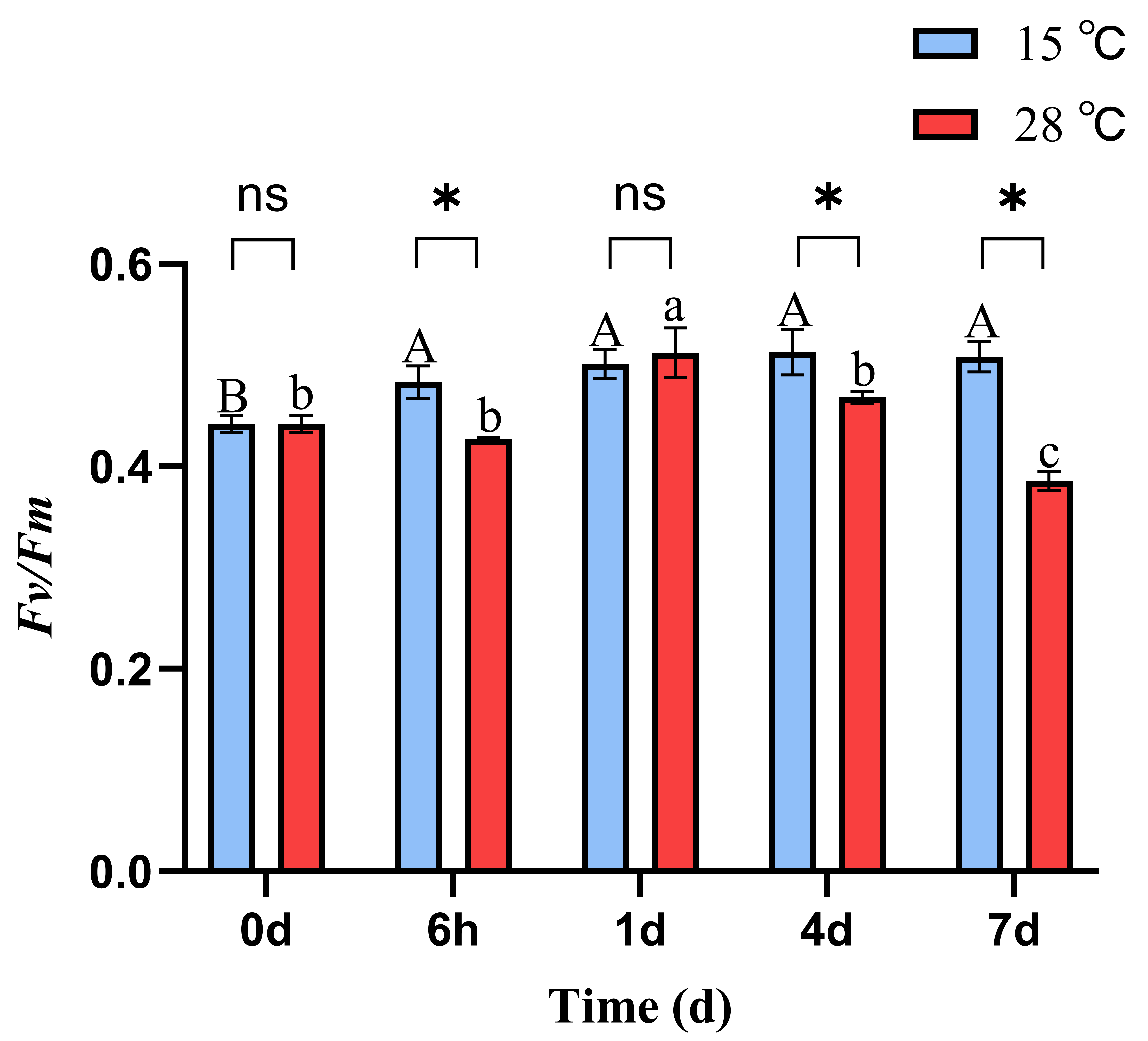
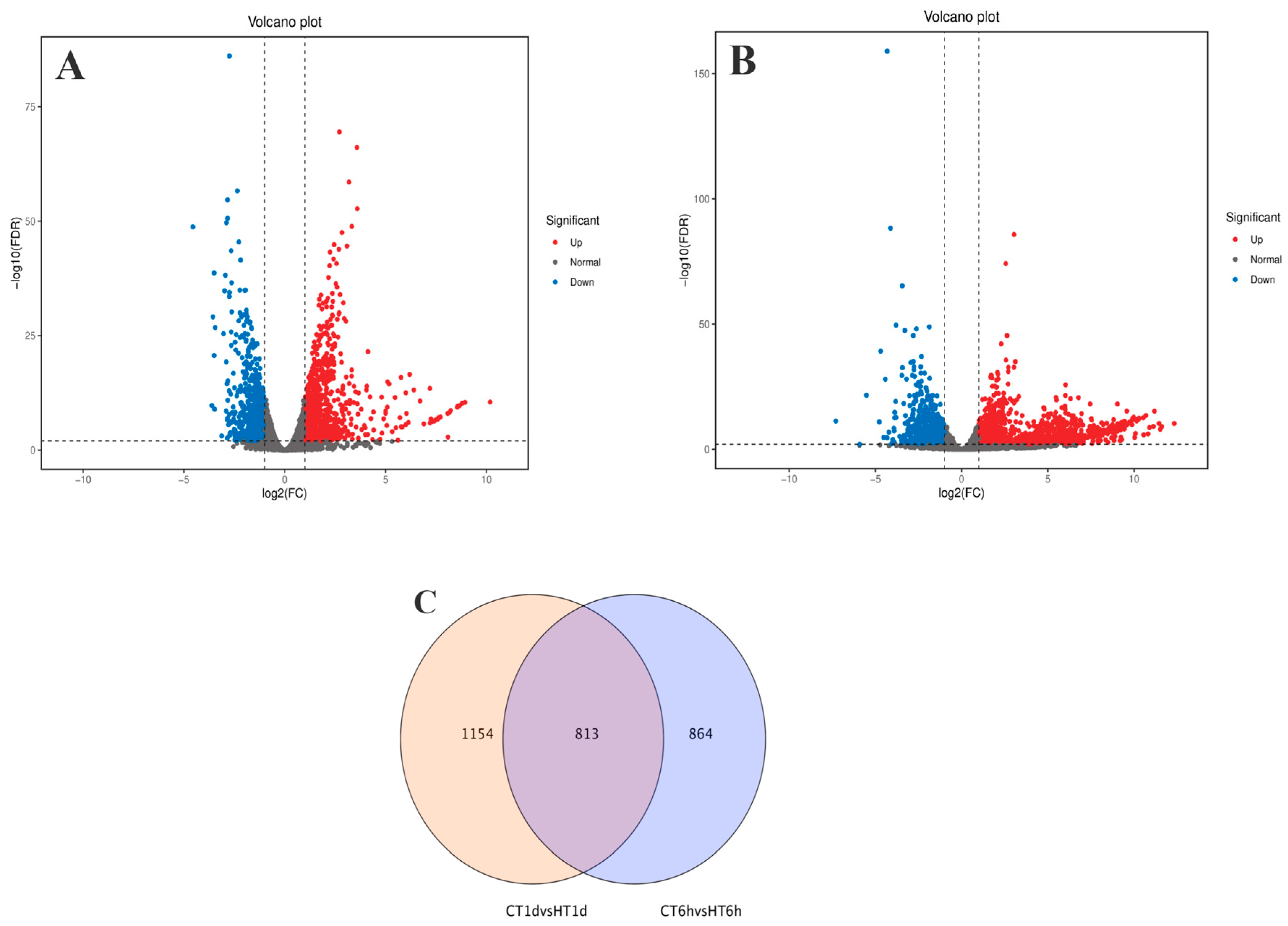

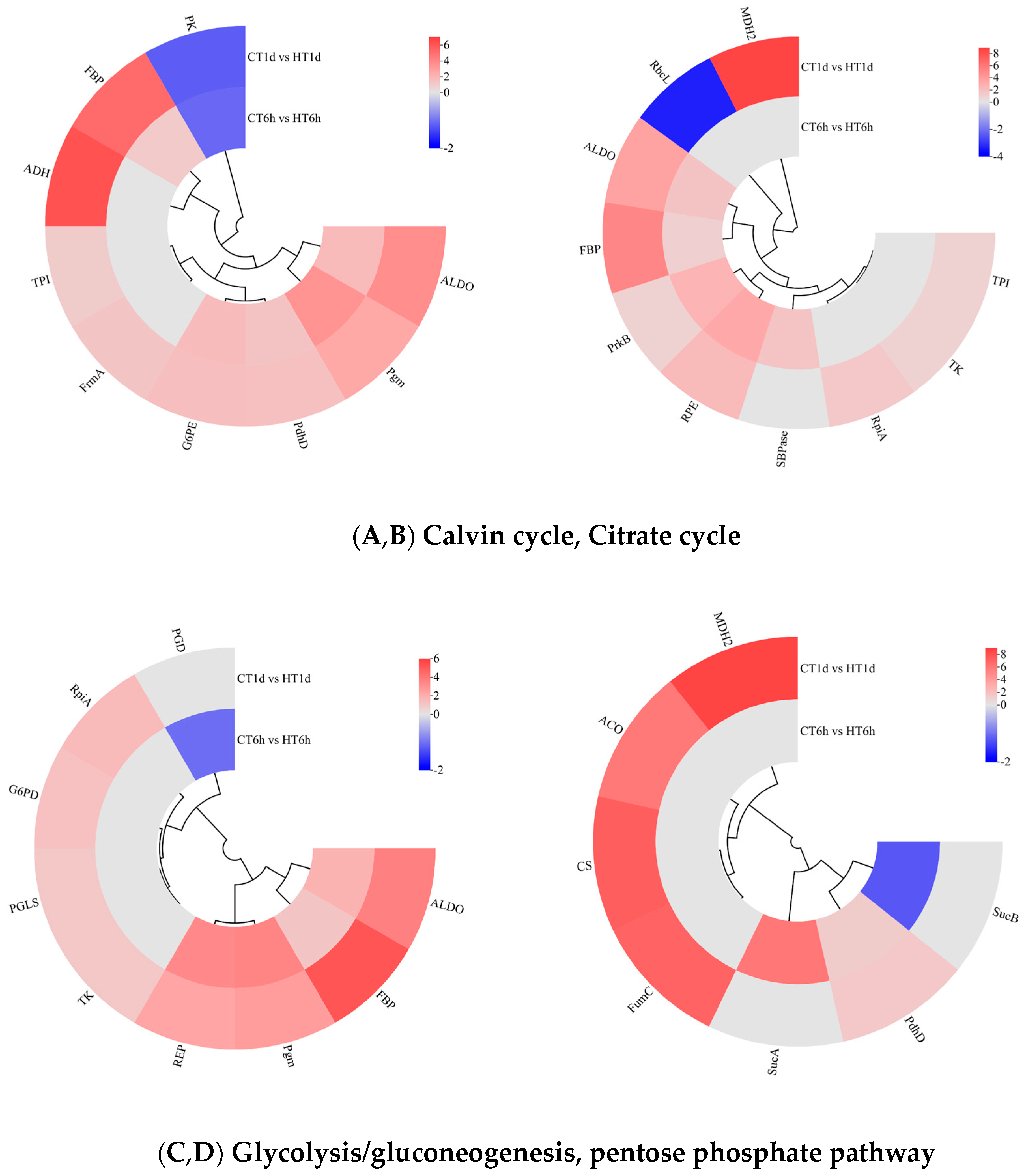

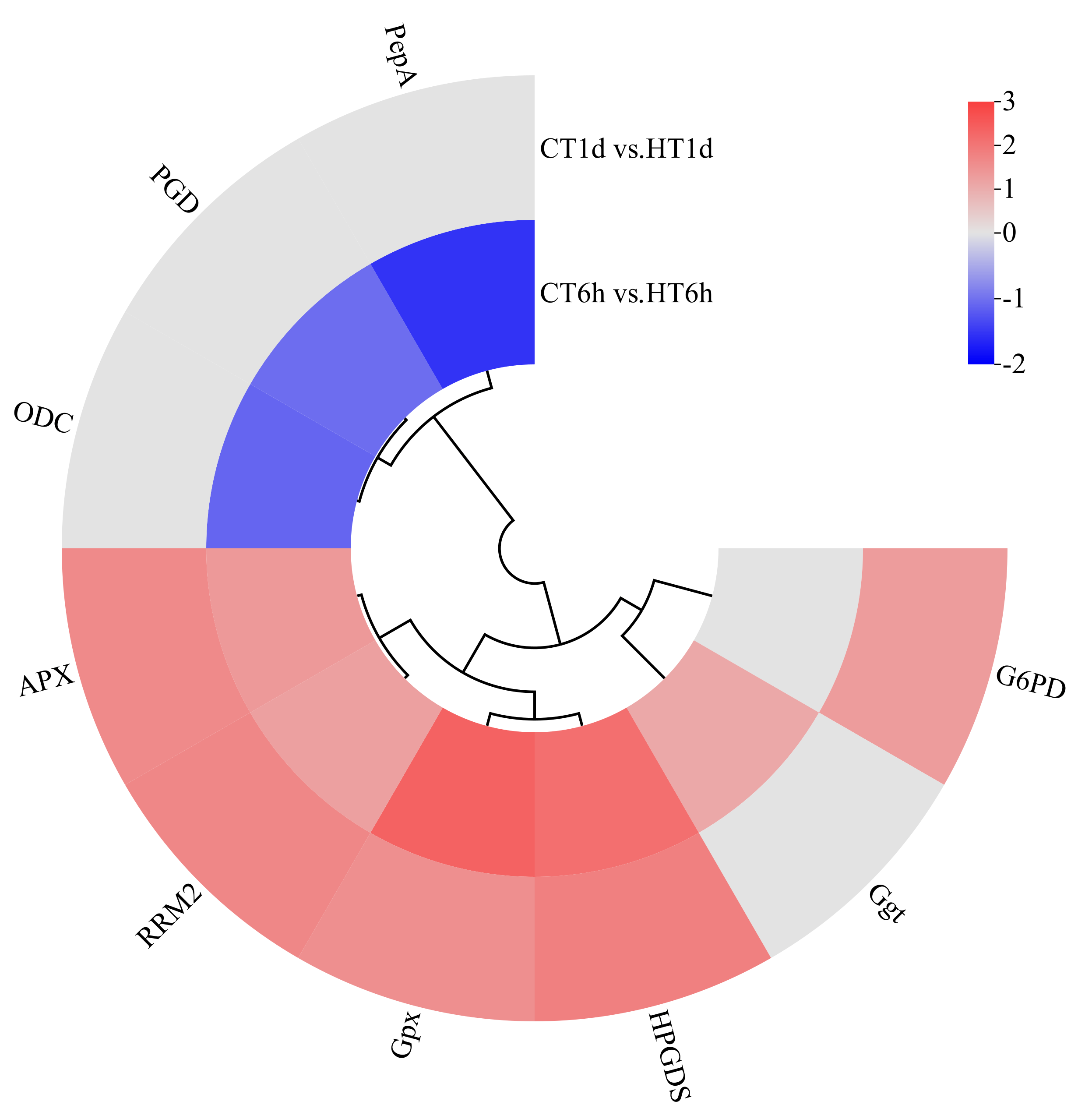
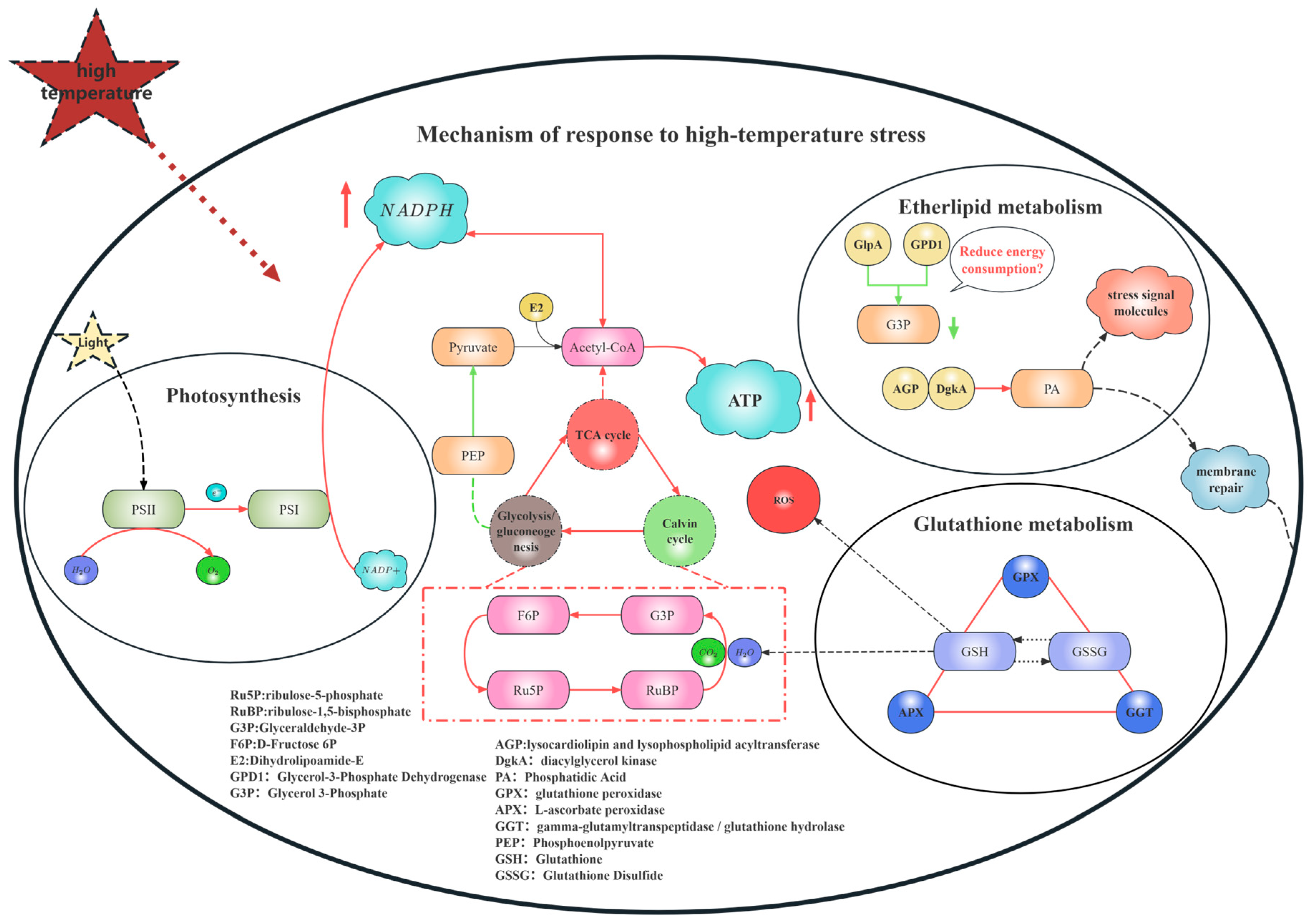
| Pathway ID | Pathway | KEGG_B_Class | No. of DEGs | p Value |
|---|---|---|---|---|
| CT6h vs. HT6h | ||||
| ko01200 | Carbon metabolism | Global and overview maps | 29 | 6.13 × 10−1 |
| ko01230 | Biosynthesis of amino acids | Global and overview maps | 20 | 6.83 × 10−1 |
| ko00860 | Porphyrin and chlorophyll metabolism | Metabolism of cofactors and vitamins | 19 | 2.87 × 10−9 |
| ko00230 | Purine metabolism | Nucleotide metabolism | 15 | 3.25 × 10−2 |
| ko00710 | Carbon fixation in photosynthetic organisms | Energy metabolism | 14 | 3.65 × 10−2 |
| ko00010 | Glycolysis/gluconeogenesis | Carbohydrate metabolism | 13 | 2.72 × 10−1 |
| ko00630 | Glyoxylate and dicarboxylate metabolism | Carbohydrate metabolism | 13 | 3.46 × 10−1 |
| ko00196 | Photosynthesis antenna proteins | Energy metabolism | 12 | 1.68 × 10−8 |
| ko00195 | Photosynthesis | Energy metabolism | 11 | 5.94 × 10−4 |
| ko00030 | Pentose phosphate pathway | Carbohydrate metabolism | 11 | 1.54 × 10−2 |
| ko00480 | Glutathione metabolism | Metabolism of other amino acids | 10 | 8.50 × 10−2 |
| ko00260 | Glycine, serine, and threonine metabolism | Amino acid metabolism | 10 | 1.15 × 10−1 |
| ko00564 | Glycerophospholipid metabolism | Lipid metabolism | 9 | 1.55 × 10−2 |
| ko00250 | Alanine, aspartate, and glutamate metabolism | Amino acid metabolism | 9 | 1.06 × 10−1 |
| CT1d vs. HT1d | ||||
| ko01200 | Carbon metabolism | Global and overview maps | 34 | 9.43 × 10−1 |
| ko01230 | Biosynthesis of amino acids | Global and overview maps | 29 | 6.66 × 10−1 |
| ko00860 | Porphyrin and chlorophyll metabolism | Metabolism of cofactors and vitamins | 16 | 6.43 × 10−5 |
| ko00630 | Glyoxylate and dicarboxylate metabolism | Carbohydrate metabolism | 16 | 5.52 × 10−1 |
| ko00710 | Carbon fixation in photosynthetic organisms | Energy metabolism | 14 | 2.87 × 10−1 |
| ko00010 | Glycolysis/gluconeogenesis | Carbohydrate metabolism | 14 | 6.69 × 10−1 |
| ko00195 | Photosynthesis | Energy metabolism | 13 | 1.05 × 10−3 |
| ko00196 | Photosynthesis antenna proteins | Energy metabolism | 12 | 8.25 × 10−7 |
| ko00480 | Glutathione metabolism | Metabolism of other amino acids | 12 | 1.59 × 10−1 |
| ko00230 | Purine metabolism | Nucleotide metabolism | 12 | 6.24 × 10−1 |
| ko00270 | Cysteine and methionine metabolism | Amino acid metabolism | 11 | 6.12 × 10−1 |
| ko00030 | Pentose phosphate pathway | Carbohydrate metabolism | 10 | 2.14 × 10−1 |
| ko00020 | Citrate cycle (TCA cycle) | Carbohydrate metabolism | 9 | 9.25 × 10−1 |
Disclaimer/Publisher’s Note: The statements, opinions and data contained in all publications are solely those of the individual author(s) and contributor(s) and not of MDPI and/or the editor(s). MDPI and/or the editor(s) disclaim responsibility for any injury to people or property resulting from any ideas, methods, instructions or products referred to in the content. |
© 2025 by the authors. Licensee MDPI, Basel, Switzerland. This article is an open access article distributed under the terms and conditions of the Creative Commons Attribution (CC BY) license (https://creativecommons.org/licenses/by/4.0/).
Share and Cite
Zhao, M.; Zheng, H.; Chen, Z.; Chen, W. Physiological and Biochemical Responses and Transcriptome Analysis of Bangia fuscopurpurea (Rhodophyta) Under High-Temperature Stress. Curr. Issues Mol. Biol. 2025, 47, 484. https://doi.org/10.3390/cimb47070484
Zhao M, Zheng H, Chen Z, Chen W. Physiological and Biochemical Responses and Transcriptome Analysis of Bangia fuscopurpurea (Rhodophyta) Under High-Temperature Stress. Current Issues in Molecular Biology. 2025; 47(7):484. https://doi.org/10.3390/cimb47070484
Chicago/Turabian StyleZhao, Minghao, Hongyan Zheng, Zepan Chen, and Weizhou Chen. 2025. "Physiological and Biochemical Responses and Transcriptome Analysis of Bangia fuscopurpurea (Rhodophyta) Under High-Temperature Stress" Current Issues in Molecular Biology 47, no. 7: 484. https://doi.org/10.3390/cimb47070484
APA StyleZhao, M., Zheng, H., Chen, Z., & Chen, W. (2025). Physiological and Biochemical Responses and Transcriptome Analysis of Bangia fuscopurpurea (Rhodophyta) Under High-Temperature Stress. Current Issues in Molecular Biology, 47(7), 484. https://doi.org/10.3390/cimb47070484






